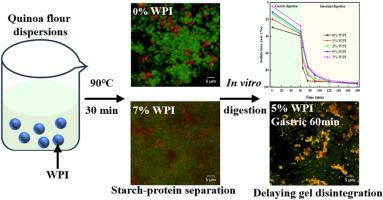Effect of whey protein on the formation, structure and gastrointestinal breakdown of quinoa flour-based composite gels
IF 11
1区 农林科学
Q1 CHEMISTRY, APPLIED
引用次数: 0
Abstract
Whole grain flours have captured increasing attention due to their health benefits. Herein, the quinoa flour-based composite gels were fabricated by heating quinoa flour dispersions containing 0–7 w/w% whey protein isolate (WPI). The thermal properties and gel formation of the dispersions were determined, along with the large deformation and fracture properties, microstructure, and molecular reorganization of the resulting gels. Protein hydrolysis, solid loss, glucose release and microstructural changes were monitored to characterize the gastrointestinal breakdown of the gels. Results showed that gelatinization of quinoa starch occurred at 60–70 °C. Upon heating, quinoa starch was segregated into microparticles of ∼3 μm, which aggregated into the starch phase, whereas protein aggregates filled the gap of the starch gel network. A bicontinuous structure was formed with increasing WPI concentration to 7 w/w%. Meanwhile, the storage modulus, gel hardness and fracture stress of the gels increased by 5–8 times. The addition of WPI inhibited gel disintegration during in vitro digestion. However, intestinal glucose release was not delayed because of the phase-separated structure of the gels. With increasing WPI concentration, larger protein aggregates survived after 5 min of intestinal digestion, demonstrating that the enhanced protein network was the main contributor slowing down gel disintegration during in vitro digestion. This work would promote the development of quinoa flour-based products with controlled digestion.

乳清蛋白对基于藜麦粉的复合凝胶的形成、结构和胃肠道分解的影响
全谷物面粉因其健康益处而受到越来越多的关注。本文通过加热含有 0-7 w/w% 乳清分离蛋白(WPI)的藜麦粉分散体,制备了基于藜麦粉的复合凝胶。研究测定了分散体的热性能和凝胶形成,以及凝胶的大变形和断裂性能、微观结构和分子重组。对蛋白质水解、固体流失、葡萄糖释放和微观结构变化进行了监测,以确定凝胶的胃肠道分解特征。结果表明,藜麦淀粉在 60-70 °C 时发生糊化。加热后,藜麦淀粉分离成∼3 μm的微颗粒,聚集在淀粉相中,而蛋白质聚集体则填充了淀粉凝胶网络的空隙。随着 WPI 浓度增加到 7 w/w%,形成了双连续结构。同时,凝胶的储存模量、凝胶硬度和断裂应力都增加了 5-8 倍。WPI 的添加抑制了凝胶在体外消化过程中的崩解。然而,由于凝胶的相分离结构,肠道葡萄糖的释放并没有延迟。随着 WPI 浓度的增加,更大的蛋白质聚集体在肠道消化 5 分钟后存活下来,这表明增强的蛋白质网络是体外消化过程中减缓凝胶崩解的主要因素。这项工作将促进开发可控消化的藜麦粉产品。
本文章由计算机程序翻译,如有差异,请以英文原文为准。
求助全文
约1分钟内获得全文
求助全文
来源期刊

Food Hydrocolloids
工程技术-食品科技
CiteScore
19.90
自引率
14.00%
发文量
871
审稿时长
37 days
期刊介绍:
Food Hydrocolloids publishes original and innovative research focused on the characterization, functional properties, and applications of hydrocolloid materials used in food products. These hydrocolloids, defined as polysaccharides and proteins of commercial importance, are added to control aspects such as texture, stability, rheology, and sensory properties. The research's primary emphasis should be on the hydrocolloids themselves, with thorough descriptions of their source, nature, and physicochemical characteristics. Manuscripts are expected to clearly outline specific aims and objectives, include a fundamental discussion of research findings at the molecular level, and address the significance of the results. Studies on hydrocolloids in complex formulations should concentrate on their overall properties and mechanisms of action, while simple formulation development studies may not be considered for publication.
The main areas of interest are:
-Chemical and physicochemical characterisation
Thermal properties including glass transitions and conformational changes-
Rheological properties including viscosity, viscoelastic properties and gelation behaviour-
The influence on organoleptic properties-
Interfacial properties including stabilisation of dispersions, emulsions and foams-
Film forming properties with application to edible films and active packaging-
Encapsulation and controlled release of active compounds-
The influence on health including their role as dietary fibre-
Manipulation of hydrocolloid structure and functionality through chemical, biochemical and physical processes-
New hydrocolloids and hydrocolloid sources of commercial potential.
The Journal also publishes Review articles that provide an overview of the latest developments in topics of specific interest to researchers in this field of activity.
 求助内容:
求助内容: 应助结果提醒方式:
应助结果提醒方式:


